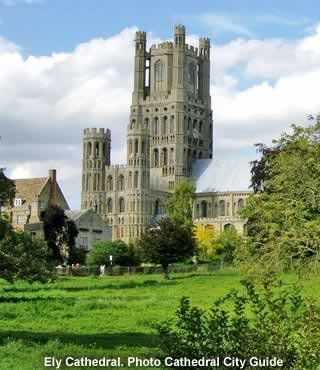Ely |
|
 |
|||
Britain > Cambridgeshire > Ely |
A city steeped in history, with a unique beauty and charm |
The city of Ely is steeped in history and has a beauty and charm all of its own. It is known as the "Jewel in the crown of the Fens". Ely probably derives its name from 'eel' and '-y' or '-ey' meaning island along with the fact that the area was formerly an island in low-lying fens, very marshy and a breeding ground for the eel population. It is said that, during the 11th century, the monks used eels as payment of their taxes. The East of England was the richest corner of the nation in the Middle Ages and the 1066 Norman conquest led to the first construction boom in history. |
Hogging the limelight in Ely is arguably one of England's most beautiful and largest Cathedrals (Church of the Holy and Undivided Trinity). This medieval cathedral is known as the "Ship of the Fens" and is also home to the only national stained glass museum. The Normans used building skills to demonstrate power over the local population and this is certainly the case here. Ely Cathedral famous for its tower took almost 300 years to complete with its complicated stonework and majestic nave. The cathedral was started by William I in 1083, suffered the collapse in 1322 of the main tower, which was rebuilt as an octagon and completed in 1351. Incredibly 1,000 years later it still as imposing as ever. |
Bishops and dioceses were abolished during the Cromwellian period and the Church of England became presbyterian. With the Restoration of Charles II, episcopacy (government of church by bishops) was restored. Reform was in the air by the 1830's and the Church, like elsewhere was experiencing much renewal and the diocese of Ely was enlarged on a huge scale by the addition of Bedfordshire, Huntingdonshire and the western half of Suffolk. |
Ely's most famous resident and former MP, Oliver Cromwell, lived and worked in Ely for many years before becoming Lord Protector of England. His 16th century home near to the Cathedral is open to the public throughout the year and visitors can learn more about him in 'museum' rooms and exhibits about 17th Century life. It is also the local Tourist Information Centre. |
The city itself is a myriad of narrow winding streets with historic buildings at every turn, many from medieval times. The River Ouse flows through the City and has free moorings (48 hr), boat trips and enjoyable walks along its beautiful waterside area. In contrast to the 'oldy worldy' there is a large modern library, museum as stated, numerous independent and well known shops as well as a busy market on Thursdays, craft market every Saturday and a Farmers' market every third Saturday. There are a wide variety of restaurants, cafes, pubs and hotels making all told a prosperous retail city with a population of over just over 15,000 and many more 'visitors'. Ely is a perfect base from which to explore the entire area being only 12 miles from the University town of Cambridge too. |
Looking back over the years Ely was always quite industrious. It had its own brewery, 'Ely Ales' and also had its own Sugar Beet plant from 1928 - 1981. Then from 1939 to late 1958 it had a Jam Factory known as St. Martin's. |
Ely Folk Festival is held annually, with 2010 marking its 25th anniversary. The Folk Festival is based on a single site which includes marquees, camping facilities, food stalls, trade stands, real-ale bar, real toilets, showers, children's entertainment, workshops, displays and even though it is a smaller festival than most it has a more and more impressive guest list every year with both new and established talent. |
|
Pocket Britain is optimised for use on a smartphone or tablet with internet access. All content is subject to copyright. All reasonable methods have been used to ensure information supplied is accurate at the time of publication. However, it is advisable to check information before relying on it. Privacy Policy |